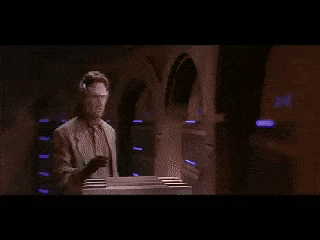The film Disclosure with Michael Douglas, taken from a book by Michael Chrichton, included a virtual reality scene that shows us that VR devices already existed in 1994, at least in the idea.
Above all, it raises a fundamental question in terms of ergonomics and virtual reality.
We see Michael Douglas, once equipped with his virtual reality device, go looking for information: he queries a database.
The film turns what could be a classic textual database into an immersive experience in the first degree: Michael Douglas finds himself in a library and will move around, manipulating cards as we did in Cambridge in the 19th century. Note that in a mainstream film, this scene is much more explicit and readable to capture the viewer’s attention.
But the question that arises is of course about the interface: from the moment immersion involves the whole body, it is tempting to strain it to the maximum and literally reproduce a real experience.
The end result is a slower and more tiring experience than with a traditional database. It’s a bit the opposite of the promise of computing: efficiency and speed.
Is it useful to reproduce reality, including its disadvantages, in such an immersive experience?
Very often, we have had requests evoking, for example, RV shopping, often in a very literal way. From the user’s point of view, what is the point of moving, getting lost, looking for products in a virtual supermarket? A lack of distance probably caused by oversold expectations of virtual and augmented reality or by interests more on the side of the brand than the user.
It would probably be more efficient to use a traditional e-commerce site.
If within the framework of a simulation, it is understandable to make a simulation in vivo; on the other hand, in the other cases, it is a question of bringing to the user certain benefits: effectiveness, stronger experience,…
Note that in a mainstream film, this scene is much more explicit and readable to capture the viewer’s attention.
But the question that arises is of course about the interface: from the moment immersion involves the whole body, it is tempting to strain it to the maximum and literally reproduce a real experience.
The end result is a slower and more tiring experience than with a traditional database. It’s a bit the opposite of the promise of computing: efficiency and speed.
Is it useful to reproduce reality, including its disadvantages, in such an immersive experience?
Very often, we have had requests evoking, for example, RV shopping, often in a very literal way. From the user’s point of view, what is the point of moving, getting lost, looking for products in a virtual supermarket? A lack of distance probably caused by oversold expectations of virtual and augmented reality or by interests more on the side of the brand than the user.
It would probably be more efficient to use a traditional e-commerce site.
If within the framework of a simulation, it is understandable to make a simulation in vivo; on the other hand, in the other cases, it is a question of bringing to the user certain benefits: effectiveness, stronger experience,…
 Note that in a mainstream film, this scene is much more explicit and readable to capture the viewer’s attention.
But the question that arises is of course about the interface: from the moment immersion involves the whole body, it is tempting to strain it to the maximum and literally reproduce a real experience.
The end result is a slower and more tiring experience than with a traditional database. It’s a bit the opposite of the promise of computing: efficiency and speed.
Is it useful to reproduce reality, including its disadvantages, in such an immersive experience?
Very often, we have had requests evoking, for example, RV shopping, often in a very literal way. From the user’s point of view, what is the point of moving, getting lost, looking for products in a virtual supermarket? A lack of distance probably caused by oversold expectations of virtual and augmented reality or by interests more on the side of the brand than the user.
It would probably be more efficient to use a traditional e-commerce site.
If within the framework of a simulation, it is understandable to make a simulation in vivo; on the other hand, in the other cases, it is a question of bringing to the user certain benefits: effectiveness, stronger experience,…
Note that in a mainstream film, this scene is much more explicit and readable to capture the viewer’s attention.
But the question that arises is of course about the interface: from the moment immersion involves the whole body, it is tempting to strain it to the maximum and literally reproduce a real experience.
The end result is a slower and more tiring experience than with a traditional database. It’s a bit the opposite of the promise of computing: efficiency and speed.
Is it useful to reproduce reality, including its disadvantages, in such an immersive experience?
Very often, we have had requests evoking, for example, RV shopping, often in a very literal way. From the user’s point of view, what is the point of moving, getting lost, looking for products in a virtual supermarket? A lack of distance probably caused by oversold expectations of virtual and augmented reality or by interests more on the side of the brand than the user.
It would probably be more efficient to use a traditional e-commerce site.
If within the framework of a simulation, it is understandable to make a simulation in vivo; on the other hand, in the other cases, it is a question of bringing to the user certain benefits: effectiveness, stronger experience,…
- Spatialization, with its spatial-cognitive impact, in my opinion often ignored. There is a very effective mnemonic method based on this principle, called the method of loci, which consists in placing objects in a known place in order to memorize them. When the user is immersed in a 3D scene, it is thus possible to put him in a similar situation to offer him a memorably impacting experience.

- In the case of an immersive experience, the emotion is striking

- In some interactive 3D applications, the use of an interface based on metaphor, for example: flying, allows to keep these cognitive impacts with great freedom. But in virtual reality where the body is involved, metaphorical interfaces work less, you have to be more literal.